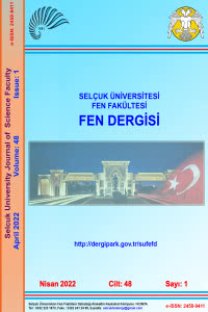EXAMINING PERFORMANCE OF STABILIZATION PONDS OF AHVAZ'S SLAUGHTERHOUSE
İran'ın Ahvaz Bölgesinde Mezbahane Stabilizasyon Havuzu ArıtmaVeriminin Araştırılması
___
- Agha, R., Heshmat, A., "Entrance of Slaughter Wastes to Watershed Basins, Contamination Factor of Water and Soil", Fourth National Conference of Science and Engineering of Iran's Watershed, Drainage Areas Management, Tehran, Iran, 2007.
- Borna, E., "Qualitative and Quantitative Review of Livestock and Poultry Slaughterhouses Sewage in Lorestan Province and Providing Management and Technical Strategies", Fifth Specialized Conference of Environmental Engineering, Tehran University, Tehran, Iran, 2002.
- Darijani, A., David, H., 2007, "Review of Pollutants of Environment Wastewater of Slaughterhouse Units", Journal of Agricultural Sciences and Natural Resources, Vol. 1, pp.25-37.
- Dehghanian, S., Farajnezhad, Z., 2000, Environmental Economics for Non-Economists: Techniques and Policies for Sustainable Development, Ferdosi Mashhad University Pulications, Mashhad, Iran.
- Daneshvar, S., 2012, "Review of Environmental Pollutants of Wastewater of Slaughterhouse Units That Have Been Studies in the "Parandak Khazar" Slaughterhouse of Som'e Sara", First National Conference On Environmental Protection And Programming, Hamedan, Iran, 2012.
- Eckenfelder, W.W., 1989, Industrial Water Pollution Control, Mc Graw-Hill, 2nd ed ,New York, pp:189- 193.
- Environmental Protection Organization of Iran, 1999, "Environmental Regulations and Standards", Published by Environmental Protection Organization of Iran, pp. 6-5.
- Farzad K., M., 2004, "Review of Efficacy of Stabilization Ponds in Sewage Treatment Plans of Kermanshah's Slaughterhouse", Journal Water and Waste Water, Vol. 15(3), pp. 15-10.
- Javarini, L., Malakootian, M., Noshadi, M., "Review of Efficiency of Sewage Treatment Systems of Kerman's Slaughterhouses", Third Specialized Conference of Environmental Engineering, Tehran University, Tehran, Iran, 2009.
- Kupusovic, T., Midzic, S., Silajdzic, I., Bjelavac, J., 2007. "Cleaner Production Measures in Smallscale Slaughterhouse Industry: Case Study in Bosnia and Herzegovin", Journal of Cleaner Production, Vol. 15( 4), pp. 278-383.
- Mara, D., 1999, "Guide to Designing Waste Stabilization Ponds in Iran", Company of Water and Wastewater Engineering of Country, Tehran, pp. 1-6.
- Manesh, E., Afyooni, M., 2009, Environmental Pollution (water, soil and air), Arkan-e Danesh Publications, sixth edition, pp. 81.
- Nejati, S., "Environmental Review of GuilanP Livestock Slaughterhouses by Using GIS system", Third National Conference of Environmental Crises And Strategies of Their Improvement, Tehran, Iran, 2006.
- Najimi, R., "Feasibility of Using Effluents of Wastewater Treatment of Industrial Slaughterhouse for Agricultural Purposes (Case study of Qom province)", Scientific Conference on Water Challenge in Qom Province, Qom, Iran, 2009.
- Reed, S.C., Crites, R.W., Middlebrooks, E. J., 1995, Natural Systems for Waste Management and Treatment, 2nd ed ,Mc Graw-Hill, New York, USA, pp.75-90.
- Stoop, M.L.M., 1999, "Application of A Mathematical Calculation Model to Reduce Slaughterhouse (Water) Pollution in Developing Countries", Technovation, Vol. 19(5), pp. 323-331.
- World Health Organization, 2006, Waste Stabilization Ponds (Design And Implementation Principles), Page 97 - 100.
- ISSN: 2147-9364
- Yayın Aralığı: 2
- Başlangıç: 2013
- Yayıncı: Selçuk Üniversitesi Mühendislik Fakültesi
EXAMINING PERFORMANCE OF STABILIZATION PONDS OF AHVAZ'S SLAUGHTERHOUSE
Mohsen YAZDANIAN, Sadegh GHASEMI, Roya MAFIGHOLAMI
DETERMINATION OF EQUIVALENT CIRCUIT PARAMETERS OF INDUCTION MOTORS BY USING HEURISTIC ALGORITHMS
EXAMINING PERFORMANCE OF STABILIZATION PONDS OF AHVAZ'S SLAUGHTERHOUSE
Sadegh GHASEMI, Roya MAFIGHOLAMI, Mohsen YAZDANIAN
ACİL DURUM HABERLEŞMESİNDE KULLANILAN EL TELSİZİNİN ÇOK ÖLÇÜTLÜ KARAR VERME YÖNTEMLERİ İLE SEÇİLMESİ
Atiye Zeynep KÜTÜKCÜ, TAMER EREN
HHO HÜCRE PERFORMANSININ BULANIK MANTIK YÖNTEMİ İLE BELİRLENMESİ
SADIK ATA, GÜROL ÖNAL, KEVSER DİNCER
ACCURACY INVESTIGATION OF DEM BASED ONGÖKTÜRK-2 STEREO IMAGES
Evren Can ÖZCAN, Sultan ÜNLÜSOY, TAMER EREN
ALİ ULVİ, Ahmet Suad TOPRAK, MURAT YAKAR
